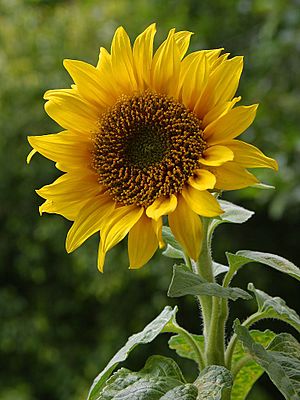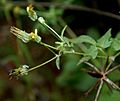Heliantheae facts for kids
Quick facts for kids Heliantheae |
|
|---|---|
 |
|
| Sunflowers have bright yellow flowers. | |
| Scientific classification | |
| Kingdom: | |
| (unranked): | |
| (unranked): | |
| (unranked): | |
| Order: | |
| Family: | |
| Tribe: |
Heliantheae
Cassini, 1819
|
| Subtribes | |
|
See text. |
|
| Diversity | |
| About 190 genera and 2500 species | |
Heliantheae is a large group of plants within the sunflower family, called Asteraceae. Its name comes from an Ancient Greek word meaning "sun flower." This group is the third largest in the sunflower family. It includes about 190 different types of plant groups, known as genera, and around 2,500 different species. Only two other groups, Senecioneae and Astereae, are bigger. Most Heliantheae plants grow naturally in North America, South America, and Mexico. A few types are found in warm, tropical places.
Contents
What Are Heliantheae Plants Like?
Most plants in the Heliantheae group are herbs (plants with soft stems) or shrubs (bushy plants). Some can even grow as tall as small trees! Their leaves are usually hairy and grow in pairs, one across from the other. The parts of the flower that hold pollen, called anthers, are often black.
How Do People Use Heliantheae?
Many plants from the Heliantheae group are very useful to humans.
Plants Grown on Farms
Some Heliantheae plants are grown on farms for food. The most famous one is the sunflower, which gives us seeds and oil. Another example is the jerusalem artichoke, which has tasty roots.
Popular Garden Flowers
Many beautiful flowers you might see in gardens also belong to this group. These include:
Weeds and Allergies
Not all Heliantheae plants are helpful. Some are considered weeds, meaning they grow where they are not wanted. One well-known weed in this family is Ambrosia, also known as ragweed. Ragweed plants produce a lot of pollen, which is a fine powder that helps plants reproduce. Each ragweed plant can release about a billion tiny pollen grains during its growing season! This pollen is carried by the wind to other plants. For many people, ragweed pollen is a main cause of hay fever, which is an allergic reaction that can cause sneezing, a runny nose, and itchy eyes.
Images for kids
See also
 In Spanish: Heliantheae para niños
In Spanish: Heliantheae para niños


